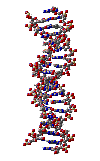|
Genetic testing for Parkinson disease? (12/2005)
Should we start being genetically tested for Parkinson’s disease (PD)? According to research just published in the December issue of the journal Movement Disorders1 this might be a possibility in the future if you belong to a family affected by G2019S, a genetic mutation responsible for some PD cases.
Parkinson disease results from the death or loss of function of the nervous cells (neurons) in a brain area called substancia nigra, which isinvolved inthe regulation of movement. Neurons within this region produce dopamine, a neurotransmitter that acts as messenger between the substancia nigra (the control centre) and other neurons around the body, leading to a correct regulation of the body movements. If the substancia nigra degenerates, like it happens in PD, dopamine is no longer properly produced and the individual starts presenting the typical symptoms of Parkinson’s disease such as slowed movements, tremors, loss of movement control and rigidity.
Although there is still no cure, treatments, which increase the brain’s dopamine levels, are relatively effective. Unfortunately, as disease progresses, treatment becomes less and less efficient and the patient’s full deterioration is inevitable. The disease affects about 1% of the world population with, only in the US, half a million people affected and about 50,000 new cases are reported every year, a number predicted to increase as the average age of the populations also increases.
In fact, among the risks factors for PD, advanced age is the most important with more than 3% of the population above 65 years old affected. In a society where life expectancy has been increasing consistently, especially in the developed world, this situation can lead to major health and economic problems emphasising the urgency to understand better the disease.
Additionally, environmental factors also seem to have an important role in the regulation of PD although which factors, is still not clear. But it is believed that toxins, slowly accumulated over time, can induce disease. One example of this effect was the observation that MPTP (a by-product of synthetic heroin), which in the 80s was sold in the streets by mistake, was able to induce severe end stage parkinsonian symptoms in several young drug abusers as result of specific destruction of the substancia nigra,as later found by autopsy. Another example is the observation that PD incidence is much higher in rural areas what have led researchers to propose that toxins in herbicides or pesticides may cause or contribute to the disease. Interestingly, both caffeine consumption and smoking seem to diminish disease incidence.
Furthermore, individuals with a family history of PD also have a higher chance of suffering from the disease. Indeed, although for a long time favoured as an environmental triggered disease, in the last decade researchers have identified several (five so far) genes, which when mutated can lead to PD.
Nevertheless, until very recently the number and importance of the cases resulting from genetic mutations was considered too low to be relevant in the overall disease panorama. This idea only started to change with the last discovered gene, LRRK2. In fact, LRRK2 mutations seem be particularly frequent accounting for 3 -6% of PD familial cases (when the mutation in inherited and so found within families in more than one individual) and around 2% of PD sporadic cases (when the mutation occurs occasionally in a random and isolated manner). These high numbers have led to a series of studies investigating the gene and its mutations in order to understand better the epidemiological importance of LRRK2.
José Miguel Bras, Rita João Guerreiro, Andrew Singleton and colleagues from Portugal and the USA decided to investigate, in a Portuguese group of 128 patients and 1400 healthy individuals, what they previously found to be the two most common LRRK2 mutations. They discovered that while one of the mutations could not be found among their patients, the other, called G2019S, was found in a remarkably high number of individuals - about 6% of the total number of patients. Very interestingly, it was also found that all the individuals with G2019S suffered from disease, while none of the healthy controls had the mutation. This suggests that G2019S is a pathogenic mutation, meaning that when it occurs in an individual it will always result in disease, in contrast with other mutations where only a fraction of the affected individuals will suffer from the illness. This conclusion was supported by previous research by the same scientists, which showed the same disease pattern in two American families with G2019S, and again a total absence of the mutation in more than 1500 healthy controls this time from the US.
Guerreiro, Singleton and colleagues’ work is important not only because it helps to understand better the dynamics of PD, but because it raises the issue of genetic testing for Parkinson’s disease among G2019S affected families or even high-risk populations. In fact, not only G2019S seems to be present in a high number of PD patients, but also is a pathogenic mutation that will lead to disease sooner or later. Genetic testing of a non-curable fatal disease is not an easy option but, although there is still no cure for Parkinson’s disease, early diagnosis and consequent treatment might result in a longer healthier life and in this sense might be a wise, even if difficult, choice for patients

1 Movement disorders (2005); Vol 20(12), Pages 1653 - 1655
“G2019S dardarin substitution is a common cause of Parkinson's disease in a Portuguese cohort”
Original paper’s authors
Jose Miguel Bras –
Andrew Singleton - singleta@mail.nih.govLink to the original paper
|
In collaboration with the Observatório da Ciência e do Ensino Superior (OCES)
Financed by the Fundação para a Ciência e Tecnologia (FCT) |





